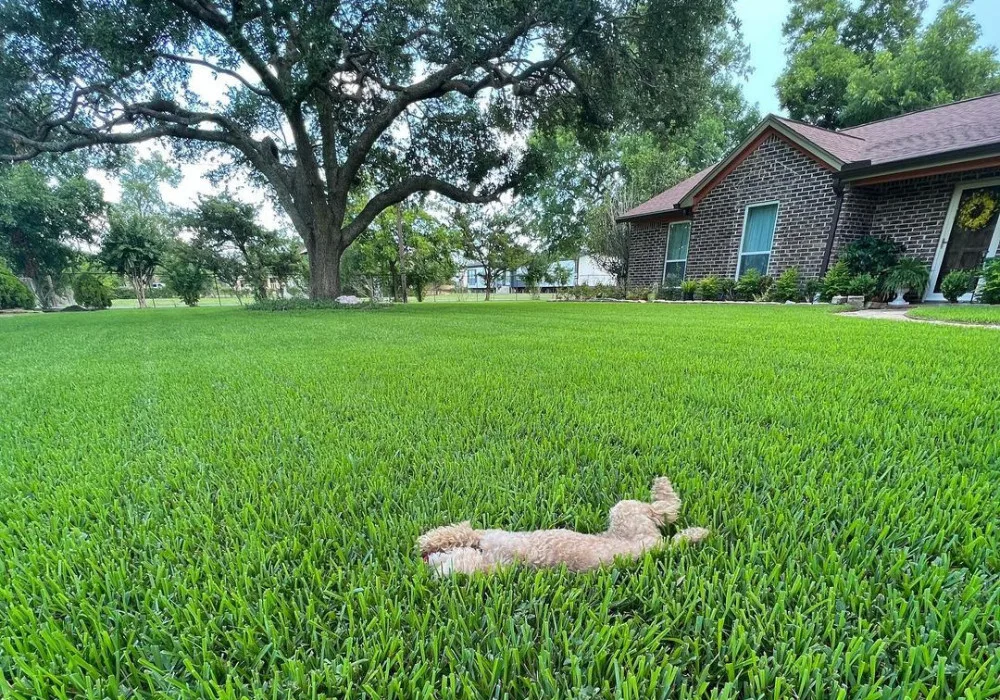It’s September in Houston—the peak heat is starting to ease, but your grass is still growing fast. This is the season when lawns either finish strong or stumble into dormancy looking stressed and patchy. And one of the biggest factors? Believe it or not, it’s the sharpness of your mower blades.
Sharp blades slice grass cleanly, helping it stay green, thick, and resilient. Dull blades rip and shred, leaving brown tips, stressed turf, and a welcome mat for weeds and fungus.

At Evergreen Outdoor Services, we mow 10–20 lawns a day. To keep every cut crisp, we sharpen our blades at least twice a week—sometimes as often as 3–5 times. Homeowners don’t need that schedule, but the principle is the same: sharp blades are the foundation of a healthy lawn.
1. Dull Blades = Weak Grass and Ugly Cuts
Think of cutting a tomato with a dull knife—you’ll crush and tear it instead of slicing it. That’s exactly what dull blades do to your grass.
-
The problem: Grass tips turn brown and frayed. The lawn thins out faster, weeds creep in, and mowing feels like more of a chore.
-
Quick insight: Torn grass loses more water and becomes more vulnerable to Houston’s biggest enemies—heat stress and fungus.

Practical tips:
-
Inspect your grass the day after mowing. Brown or frayed tips mean blades are dull.
-
Avoid mowing wet grass—it clogs the deck and dulls blades faster.
-
Don’t wait for visible damage. By then, stress has already set in.
-
-
Local example: In Kingwood and Summerwood, we’ve seen lawns turn patchy not because of poor fertilizer, but simply from being mowed with dull blades week after week.
Pro Tip: If your lawn looks brown at the tips right after mowing, the blades are past due for sharpening.
2. Sharpening 101: How Often and How To
Our crews sharpen blades multiple times a week because of our schedule—mowing 10–20 lawns a day. But the average homeowner doesn’t need to do that.
-
Best practice for Houston homeowners: Sharpen your mower blades once every 2–3 months during the growing season. If you mow weekly, that’s roughly every 20–25 hours of mowing time.
-
Why it matters: Consistency is key. Letting grass grow too tall between cuts dulls blades faster and makes the mower work harder.

Tips:
-
Always balance blades after sharpening—unbalanced blades cause vibration that damages your mower.
-
Replace blades every 1–2 years if they’re nicked, bent, or worn thin.
-
If your soil is sandy (common in Crosby, Humble, and Atascocita), check blades more often since sand dulls them quicker.
-
-
Local example: Homeowners who sharpen just three times a year (spring, midsummer, fall) see greener lawns and fewer brown tips compared to neighbors who wait all season.
3. Safety and Disease Prevention | Sharp mower blades in Houston
Sharp blades don’t just help your grass—they protect you and your mower.
-
The problem: Dull blades snag and pull, making the cut harsher on the grass. Plus, torn grass is like an “open wound,” giving fungus and pests an easy way in.
-
Quick insight: A clean cut reduces stress on grass and minimizes fungal spread, especially in Houston’s humid summers. Below is a example of a clean cut on a grass clipping.

-
Practical tips:
-
Disconnect the spark plug before removing or sharpening blades.
-
Wear gloves—blades don’t have to look sharp to cut skin.
-
Sanitize blades with rubbing alcohol if you mow through fungus patches to avoid spreading spores.
-
Never ignore heavy vibration—it’s often a sign of an unbalanced or damaged blade.
-
-
Local example: In Humble, a St. Augustine lawn we treated for fungus rebounded twice as fast when the homeowner kept blades sharp and sanitized after each mow.
FAQ
Q1: How do I know if my mower blades are dull?
Check the grass tips a day after mowing. If they look brown or frayed, your blades are dull.
Q2: How often should I sharpen blades in Houston?
For most homeowners, every 2–3 months during the growing season. More often if you mow sandy soil.
Q3: Can I sharpen blades myself?
Yes, with a grinder or file. Just make sure to balance the blade afterwards. Many homeowners use a shop for convenience.
Q4: Do sharp blades really prevent weeds and fungus?
Indirectly, yes. Healthy grass is denser and crowds out weeds, while clean cuts reduce fungal entry points.
Final Thoughts & Clear Next Step | Sharp mower blades in Houston
The secret to a beautiful Houston lawn isn’t just watering and fertilizer—it’s sharp mower blades. Clean cuts mean stronger, greener grass, fewer fungal issues, and less stress on both your lawn and your mower.
Seasonal tip: September is the perfect time to sharpen blades before fall. Houston lawns are still growing, but cooler nights are around the corner. A clean cut now helps your grass stay thick and healthy going into dormancy, which means fewer weeds and a greener start next spring.
Here’s your next step, depending on what kind of homeowner you are:
-
Like to DIY? Search YouTube for guides specific to your mower model. They’ll show you how to safely remove, sharpen, balance, and reinstall blades.
-
Enjoy mowing but don’t want to hassle with sharpening? Take your blades to a local shop—most charge just $5–20 for sharpening.
-
Prefer to set it and forget it? Hire a professional lawn care company. At Evergreen Outdoor Services, we handle sharpening multiple times per week so you never have to worry about cut quality.
“Evergreen keeps our lawn looking sharp—literally. Their mowing has made such a difference in how healthy our grass looks.” — Gilbert C, Summerwood




